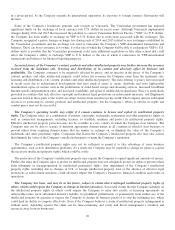Time Magazine 2015 Annual Report Download - page 31
Download and view the complete annual report
Please find page 31 of the 2015 Time Magazine annual report below. You can navigate through the pages in the report by either clicking on the pages listed below, or by using the keyword search tool below to find specific information within the annual report.could incur significant programming impairments, which could have a material adverse effect on the Company’s results of
operations in a given period.
The failure to renew agreements with affiliates on favorable terms or at all could cause the Company’s subscription
and advertising revenues to decline. The Company depends on agreements with affiliates for the distribution of the
Company’s cable networks, premium pay television and streaming services. Competition from SVOD and other OTT
services and new distribution platforms and declines in multichannel video service subscribers is increasing the pressure on
affiliates to control their programming costs in order to maintain their profitability while offering their services at prices that
enable them to continue to attract and retain subscribers. As affiliates continue to try to control their programming costs, it
may be more difficult for the Company to secure favorable terms, including those related to pricing, positioning and
packaging, during renewal negotiations with affiliates, and the Company may face greater difficulty in achieving placement
of its networks in smaller bundles being offered by affiliates. The Company’s efforts to capitalize on new growth
opportunities outside the traditional TV ecosystem may also make it more difficult to secure favorable terms during renewal
negotiations with affiliates. An additional factor making it more difficult to secure favorable terms during renewal
negotiations is the consolidation of affiliates in the U.S. and growth of large multi-territory distribution companies
internationally, which increases their scale and negotiating power.
If the Company is not able to secure favorable terms when it renews its affiliate agreements, its subscription revenues may
not increase as much as the Company expects or could decline. In addition, the inability to renew one or more of the
Company’s larger affiliate arrangements would reduce the number of households that have access to Turner’s cable networks
and result in lower ratings for programming, which could make those networks less attractive to advertisers and result in
lower growth or a decline in advertising revenues.
Some initiatives to respond to and address the changes to the U.S. television industry and consumer viewing patterns
may be outside the Company’s control. While the Company supports the development of better consumer interfaces, the
development and implementation of these interfaces are often outside the Company’s control. In addition, the Company may
not be able to introduce new business models and products to enhance the value of multichannel video subscriptions to
consumers without the cooperation of affiliates.
If the rate of decline in the number of multichannel video service subscribers increases, the Company’s subscription
revenues will be negatively affected. During 2014 and 2015, the number of multichannel video service subscribers in the
U.S. declined slightly, and the Company expects further modest declines. If multichannel video service offerings are not
attractive to consumers due to increases in rates, increased competition from SVOD and other OTT services, worse economic
conditions or other factors, more consumers may (i) cancel their multichannel video service subscriptions or choose not to
subscribe to multichannel video services, (ii) cancel their subscriptions to premium pay television services or (iii) elect to
subscribe to lower-priced streaming services or smaller bundles of networks offered by affiliates, which may not include
HBO, Cinemax or some of Turner’s cable networks. The number of HBO and Cinemax subscribers could also decline if
affiliates choose not to market, or reduce their marketing of, HBO or Cinemax. If the rate of decline in the number of
multichannel video service subscribers increases or if subscribers shift to affiliates’ lower-cost streaming services or smaller
bundles of networks that do not include all of the Company’s cable networks and premium pay services, the Company’s
subscription revenues will be negatively affected.
A decrease in demand for the television programming produced by Warner Bros. could adversely affect the Company’s
revenues. Warner Bros. is a leading producer of high-quality television programming, as well as a leader in the international
distribution of U.S.-produced television programming. Even with its strong competitive position, Warner Bros.’ television
production business is largely dependent on the strength of the U.S. broadcast networks, basic cable networks and local
television stations, and their continued demand for Warner Bros.’ television programming. If there is a decrease in such
demand, it could decrease the overall scale of Warner Bros.’ television production business, reduce the aggregate license fees
for its television programming in the short-term and reduce the aggregate syndication revenues for its television
programming in the long-term. The following factors could increase the likelihood of a decrease in such demand in the U.S.:
(i) for vertically-integrated networks, increased reliance by such networks on their in-house and affiliated television
production studios, which can provide them more control over intellectual property rights and syndication and license fees in
the U.S. and internationally; (ii) technological advances and alternative viewing options that could reduce the lifetime value
of television programming; and (iii) consolidation among television station groups, thereby reducing the number of buyers
17
























